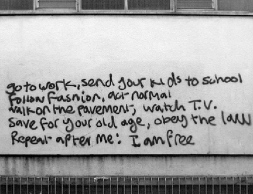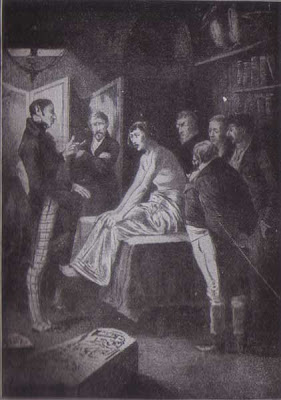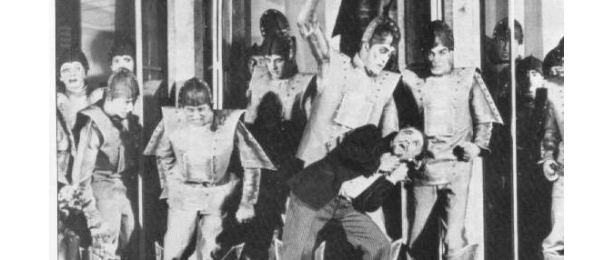A friend recently directed me to this post, which is a survey of 19th and early 20th century science fiction that came out of a conference discussion of the same (it actually extends a bit before and Victoria and after Edward, but categorizing based on monarchs’ names sounds legit and scholarly or whatever). As someone who has studied and taught the history of the genre, I was interested in what the list compilers/panelists included. It’s a solid list, to be sure. And, as expected and acknowledged by the authors/participants, the list is dominated by a few usual suspects with pretty homogeneous backgrounds. Partial list below the cut (the author, David Malki, has linked to online texts where available):
TIME TRAVEL
- Irving, Washington. RIP VAN WINKLE. (1819) // learn more // read online
- Poe, Edgar Allan. SOME WORDS WITH A MUMMY. (1845) // learn more // read online
- Morris, William. A DREAM OF JOHN BALL. (1888) // learn more // read online
- Twain, Mark. A CONNECTICUT YANKEE IN KING ARTHUR’S COURT. (1889) // learn more // read online
- Wells, H.G. THE TIME MACHINE. (1895) // learn more // read online
- London, Jack. THE STAR-ROVER. (1915) // learn more // read online
HOLLOW EARTH
- Verne, Jules. JOURNEY TO THE CENTER OF THE EARTH. (1864) // learn more // read online
- Butler, Samuel. EREWHON. (1872) // learn more // read online
- Harben, William. THE LAND OF THE CHANGING SUN. (1894) // learn more // read online
- Merritt, A. THE MOON POOL. (1918) // learn more // read online
UTOPIA/DYSTOPIA
- Bellamy, Edward. LOOKING BACKWARD. (1888) // learn more // read online
- Howells, William Dean. A TRAVELER FROM ALTRURIA. (1894) // learn more // read online
- Gilman, Charlotte Perkins. HERLAND. (1915) // learn more // read online
FUTURE OR STRANGE WORLDS
- Swift, Jonathan. GULLIVER’S TRAVELS. (1726) // learn more // read online
- Verne, Jules. PARIS IN THE TWENTIETH CENTURY. (1863) // learn more // no free online edition
- Abbott, Edwin. FLATLAND. (1884) // learn more // read online
- Forster, E.M. THE MACHINE STOPS. (1909) // learn more // read online
. . .
WORLD CATASTROPHES
- Shelley, Mary. THE LAST MAN. (1826) // learn more // read online
- Donnelly, Ignatius. RAGNAROK, THE AGE OF FIRE AND GRAVEL. (1883) // learn more // read online
- Flammarion, Camille. THE END OF THE WORLD. (1893) // learn more // no free edition online
- Doyle, Arthur Conan. THE POISON BELT. (1913) // learn more // read online
SOCIAL AND POLITICAL REVOLUTIONS
- Griffith, George. THE ANGEL OF THE REVOLUTION. (1893) // learn more // read online
- Griffith, George. OLGA ROMANOFF. (1894) // learn more // read online
- Conrad, Joseph and Ford Madox Ford. THE INHERITORS. (1901) // learn more // read online
- London, Jack. THE IRON HEEL. (1908) // learn more // read online
- Kipling, Rudyard. AS EASY AS ABC. (1912) // learn more // read online
- Lewis, Sinclair. IT CAN’T HAPPEN HERE. (1935) // learn more // read online
This gives me a number of things I should probably check out in the near future, but I’m also surprised at how much of this I’ve actually already read. Quite glad to see Shelley’s The Last Man make it in as it is arguably the first post-apocalyptic novel. A few comments on inclusions and suggestions for additions:
I’m a bit surprised at the inclusions to the time travel category. I guess I don’t really think of “Rip Van Winkle” or “Some Words with a Mummy” as time travel stories (though they certainly anticipate them). Poe’s “Some Words” is a great, fun story everyone should read, though. It’s a brutal satire of human hubris and teleological thinking, and it shows a side of Poe that too few are familiar with.
I’m also surprised at the brevity of the Utopia/Dystopia category, especially given how many of them were written in the 19th c. I’m not going to try to put together a full list (that can be found elsewhere), but News From Nowhere really ought to be added, at the very least. There are, however, texts on the list that also fit this category but are placed elsewhere (“The Machine Stops,” The Iron Heel).
A few notable suggestions for the list (most either p-a or utopia/dystopia, as anyone who knows me would expect). Apologies for not finding more diversity, but it is indicative of the publishing climate of the era (and genre), I suppose:
Capek, Karel. R.U.R. (1920) // learn more // read online
A bit toward the end of the era, and it’s a play, but one of the most important early 20th science fiction texts.
Jefferies, Richard. After London, or Wild England. (1885) // learn more // read online
A bit dry, but at least book 1 is a must-read for those interested in the post-apocalyptic genre.
London, Jack. The Scarlet Plague. (1912) // learn more // read online
Important and overlooked American post-apocalyptic novel. Anticipates Earth Abides (amongother things).
Lovecraft, H.P. “Herbert West–Reanimator.” (1922) // learn more // read online
I only picked this particular Lovecraft because it is clearly science fiction (whereas a lot of other possible choices are more debatable, which is one of the reasons I love weird fiction). Lovecraft, and probably a few of his contemporaries, deserve a mention on this list even if they represent a shift away from the era in question.
Morris, William. News from Nowhere. (1890) // learn more // read online
Along with Bellamy’s Looking Backward, one of the two most important utopias of the 19th c. Also, historically interesting beyond politics in its influence on the garden movement during the era.
Poe, Edgar. “The Conversation of Eiros and Charmion.” (1839) // learn more // read online
A dialogue rather than a traditional “story,” here we have some of Poe’s philosophical musing (as seen at greater length in Eureka)in a post-apocalyptic setting. Great teaching text.
Shiel, M. P. The Purple Cloud. (1901) // learn more // read online
One of the craziest books from the era . . . in a good way.
Zamyatin, Yevgeny. We. (1921-22) // learn more // read online
In my book, this is the most glaring omission from the list (I know it wasn’t intended to be comprehensive, but still). Arguably the first dystopian novel; highly influential. I initially thought it was too late to make it on, but the list extends later than its composition (and suppression) and the publication of the English translation (in 1924 by Gregory Zilboorg).
That’s all I can come up with off the top of my head and by looking at my dissertation-related (ie, post-apocalyptic and dystopian) bookshelves across from where I’m sitting, but I’m sure there are others.




In “defense” of the original compilers (and my own biases), I think they were interested in “Victorian and Edwardian” science fiction because it’s so often proto or semi-science fiction, at least as we conceive of it. So I would say that We, R.U.R., and some of the others coming post-WWI qualify as modernist as well as, clearly, science-fiction, hence their “omission.”
Fair point; both R.U.R. and We are decidedly modernist works (Lovecraft . . . not so much). I would, however, ask whether Forster’s “The Machine Stops,” which was included in the original list, isn’t also modernist despite its early date of publication.
Reblogged this on Prince Cavallo and commented:
Here’s my first Reblog and I’m partly doing it as a personal aide memoire – I’ve read a few Victorian Science Fiction novels (I grew up on HG Wells!) and I want to explore more, so this might prove to be a good starting point…
Thanks for mentioning Shiel and “The Purple Cloud”. Shiel had an interesting life to say the least, and the Purple Cloud in particular is a fascination reflection of his character. It does fit under the umbrella of Science Fiction but sits more comfortably as Fantastic Fiction, along with authors like David Lindsay.
Sorry, that should read “fascinating”
Wow, I forgot all about Lindsay. Voyage to Arcturus is going on my need to re-read shelf.